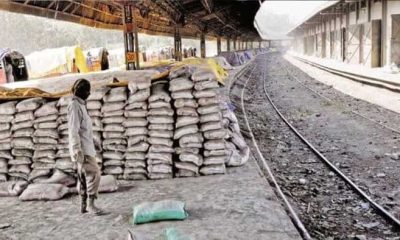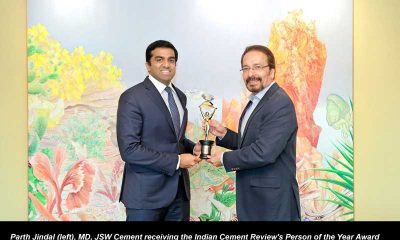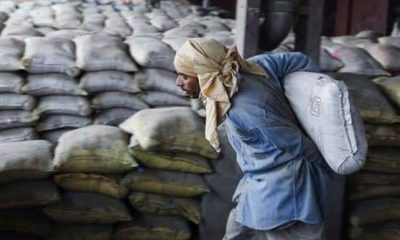Environment
The accusations of cartelisation, if any, are totally incorrect and ill-founded
Published
13 years agoon
By
admin
Vinita Singhania, Managing Director, JK Lakshmi Cement Ltd, and President, Cement Manufacturers’ Association (CMA) in an e-interview with Indian Cement Review, explains her priorities, defends accusations and puts forth her suggestions for the growth of Indian cement industry.
Now that the Budget 2011-12 has been announced, what are your priorities for the Indian cement industry?
My main priority for the cement industry is to arrange/mobilise adequate raw materials and infrastructure so that the industry can grow at the required rate to meet the emerging demand of the nation in the next one decade. Indian cement industry today faces acute shortage of fuel for production as well as for its power requirement, wagon for its movement of cement and more importantly, bulk handling infrastructure at the cement unloading/consumption points. Further, since the Budget has not addressed the long pending concern of the industry with respect to the high taxation burden, the priority to sensitise and convince the authorities about the same remains an important item on the Industry’s agenda.
What has the Budget badly missed out, which would have propelled the industry to greater heights?
As mentioned earlier, the issue of high taxation on cement industry which results in high cost of cement to the end-consumers needs to be looked at by the government afresh, recognising that cement is an essential input for the country’s infrastructure development as also for common man’s housing requirement.
The Budget does not incentivise efficient working in the cement industry atleast. Neither it has encouraged the modern method of construction/products like RMC, AAC blocks etc, which are not only environment-friendly but if which encouraged can reduce the load on the country’s resources and infrastructure. Instead of any incentive products like fly ash, slag, RMC are now being subjected to excise rate of one per cent. With imaginative use of taxation on these products their consumption could have been encouraged.
What is your opinion on the reduction in import duty on pet coke and gypsum? What would be its impact on production cost?
Reduction in import duty on pet coke and gypsum is a positive move though the reduction is still only half way meeting the industry’s requirement which faces an anomaly of cement being imported at zero per cent import duty while the import of its raw material was being subject to 5 per cent import duty which has been reduced to 2.5 per cent in the Budget. It can possibly impact the production cost by about one per cent to those units who are dependent on imported coal or pet coke and who are situated closer to the ports. The rest of the cement plants which form a major chunk remain unaffected.
The government has restructured the excise duty by bringing in composite rates having an ad valorem and specific component. What would be its impact on the cement price?
The dual system of excise on cement is now prevalent for the fifth year. The bigger question is not that one of ad valorem vs specific rate. The issue is that since in a commodity like cement post manufacturing expenses are very high, notably that of freight, the excise duty if charged on ad valorem rate, should also have a provision for abatement on such post manufacturing expenses. In fact, the government has been providing abatement to many industries, including white cement. The cement (grey) industry, however, continues to remain deprived of this abatement causing hardship to the industry.
The surcharge limit on corporate tax has been brought down to 5 per cent from 7.5 per cent and the minimum alternate tax (MAT) has been increased to 18.5 per cent from the existing 18 per cent. What would be its impact on the industry?
The reduction of surcharge on corporate tax by 2.5 per cent and increase in MAT rate from 18 to 18.5 per cent has resulted in increase in overall MAT rate by 0.08 per cent and decrease in corporate tax by 0.77 per cent. This has widened the gap by 0.85 per cent in normal corporate tax and MAT rate.
The resultant gap between the normal tax and MAT will negatively impact the capital investments as also the cash flows of companies on MAT.
There is always an accusation of cartelisation in the cement industry, which leads to artificial hike in price. Your comments on this allegation.
The accusations of cartelisation, if any, are totally incorrect and ill-founded.
On one hand, a price hike is announced every alternate week while on the other, the industry faces a serious under-utilisation of capacity. Can you explain this anomaly?
It would be incorrect to say that price hikes are announced every alternate week. For instance, in the area where our company JK Lakshmi Cement operates, we have not seen any price increase from March 2010 to January 2011 though, yes, we did see price declining a number of times. The industry normally faces this dilemma that whenever the prices decline the capacity utilisation also declines. This is understandable as cement prices are a direct off-shoot of demand and supply and whenever the supply increases on account of new capacity creations the overall capacity utilisation falls if the demand is not able to keep pace with the addition in the capacities.
Since the capacity is under-utilised, are there any plans to bolster the export?
The exports this year are at about the same level as last year. Indian cement industry is a marginal player in the international cement trade on account of its high inland cost of transportation. Also in the recent times consequent to the recession of 2008-09 the international demand for cement continues to be at low ebb. The Indian cement industry, therefore, has been finding it difficult to even maintain its previous level of exports.
Coal being the main fuel for the industry, its availability is depleting at a faster rate. How the use of alternate fuel can be encouraged?
Cement industry has been experimenting with alternate fuel for last many years now. Many cement plants in the country, including ours, have taken lead in working with alternate fuel like pet coke, lignite, agricultural waste, biomass, etc. One obvious way to encourage the use of alternate fuel would be to offer excise duty concession to the extent cement produced from the alternate fuel and if that alternate fuel is an industrial waste then the waste generating industry must compensate by some levy mechanism to promote utilisation of such industrial wastes.
With conventional source of energy getting dearer and environmentally risky, how is the industry embracing renewable source of energy?
One of the methods increasingly being resorted to by the cement industry is by greater usage of waste heat from the kilns and convert it into power.
How do you see the acceptance and evolution of blended cement in India?
By and large, the blended cement is now well accepted in many segments of the users. Surprisingly, the greater resistance comes from the public sector or government departments who for reasons best known to them continues to insist on usage of OPC. I feel there would have to be greater intervention by the government to ensure that usage of blended cement is made compulsory.
Cement companies are selling PPC at the same price as they would have sold OPC by adding flyash and hence there is more margin for cement companies in selling PPC. Your comments.
It would be incorrect to generalise that cement companies are selling PPC at the same price as that of OPC. In major parts of our markets, for instance, OPC commands a premium of Rs 15 to 20 a bag over PPC. In the markets where the price gaps are lower cement companies lose by selling more of OPC. In a way it is only appropriate that the cement companies should gain by manufacturing PPC and that is the only way the industrial waste like fly ash, slag, etc can be utilised in greater quantity.
RMC, being value-added product, is still in its nascent stage. What steps can be taken to encourage the use of RMC?
RMC off late in mature market is showing a trend of good growth. We expect this trend to continue and the use of RMC to grow in Tier II and III cities. The industry has to take certain steps to make RMC available, acceptable and affordable to the customers in Tier II and III cities.
Cement demand is driven by the housing market to the extent of 70 per cent and balance by infrastructure, etc. Given the pace of investment happening in infrastructure, do you foresee a shift in demand drivers?
To the best of our judgement, the consumption of cement in building construction is about 60-65 per cent and that would include building for housing as well as for commercial and infrastructure. Clearly, with greater emphasis on infrastructure development there would be gradually higher requirement by the infrastructure sector.
Many cement companies have reported loss in Q3. What are the factors affecting the companies? What remedial measures would you suggest in this regard?
Cement industry in the Q2 and Q3 has faced twin pressures, viz, falling cement prices and increasing cost of production. Fuels, both nationally and internationally, have seen a great upsurge in its prices thereby putting pressure on the cost of production while additional capacities which have created a situation of surplus, impacted the prices negatively.
Do you see mergers and acquisitions happening in near future? Is the cement industry ready for consolidation?
The current level of valuations do not make mergers and acquisitions attractive as the cost of acquiring capacity is higher than the cost of creating new capacity. In the past mergers and acquisitions have taken place as many MNCs who were wanting to establish themselves/or expand in India paid premiums. In immediate future with the current level of valuations I do not see much activity on this front but there could be surprises, I can’t be sure.
Concrete
Filtration can help to control climate change
Published
4 days agoon
April 16, 2024By
admin
Niranjan Kirloskar, Managing Director, Fleetguard Filters, elaborates on the importance of filtration and its profound impact on efficiency, longevity and environmental sustainability.
Tell us about the core principle of filtration.
Filtration is segregation/separation of matter by density, colour, particle size, material property etc. Filtration is of four basic types:
- Separation of solids from gas
- Separation of solids from liquids
- Separation of liquids from liquids
- Separation of Solids from solids.
As applied to engines/equipment, the main objective of filtration is to purify the impurities and provide the desired fluid or air for enhanced engine/equipment performance in turn optimising their performance and life.
Can better filtration bring productivity to the work process? How?
Better filtration can improve the quality of application performance in multiple ways. Filtration improves engine performance as it filters and prevents dirt, dust, and debris from entering into the engine. This ensures that the quality of air or fluid that reaches the combustion chamber is as per the specific requirements of optimal performance of the engine. It also extends engine life by filtering out contaminants. Efficient filtration ensures optimal performance of the engine/equipment over its entire operating life. Filtration also improves fuel efficiency as a clean filter allows for a better air-fuel mixture in the engine, thus improving combustion efficiency, which in turn results in better fuel economy. It keeps emissions under control as fuels burn more efficiently leading to lesser harmful residue in the environment. Thus, to sum up, an optimal filtration solution ensures better performance, prolonged engine life and less hazardous waste in the environment.
What is the role of technology in the process of filtration?
Innovation, research and development as well as technology play a pivotal role in catering to the ever-evolving environmental norms and growing market demands. At FFPL we have NABL Accredited labs for testing, we have ALD Labs for design, and a team of R&D experts constantly working on providing advanced solutions to cater to the evolving market needs. We have robust systems and advanced technologies that make high-quality, high-precision products. Our state-of-the-art manufacturing facilities use advanced technologies, automation, robotics and also Industry 4.0 as applicable to provide the best products to our customers. To ensure each product delivered to market is of utmost precision, advanced quality equipment such as CMM, scanning systems and automated inspection technologies for real-time monitoring and quality control during the manufacturing of filtration systems and to comply with standard quality requirements are used.
Tell us about the impact of good filtration on health and the environment.
Good filtration of equipment is to the environment what a good respiratory system is to the body. There are various benefits of an efficient air filtration system as it improves the air quality by ensuring optimum combustion of fuel thereby reducing/controlling emissions to the environment. Efficient lube filtration ensures low wear and tear of the engine thereby extending life of the engines and maintaining optimal performance over the entire operating life of the engine. Efficient fuel filtration ensures low wear and tear of expensive and sensitive fuel injection thereby ensuring perfect fuel metering resulting in best fuel efficiency and saving of precious natural resources. This efficient filtration can help to control climate change as it reduces the carbon footprint due to combustion in the environment.
Can your products be customised and integrated with other machinery?
Fleetguard Filters have been known as a leading solutions provider for decades. With relevant experience and close customer relations, we understand the market/applications requirements and develop solutions to address the pressing technical challenges our customers face concerning filtration solutions. Filters can be customised in terms of size, shape and configuration to fit specific requirements. Customised filters can be designed to meet critical performance requirements. Filtration systems can be designed to integrate seamlessly with any auto and non-auto application requirements.
What are the major challenges in filtration solutions?
Major challenges faced in filtration solutions are:
- With every emission regulation change, filtration requirements also keep changing.
- Engines are being upgraded for higher power ratings.
- Space for mounting filtration solutions on vehicles/equipment is shrinking.
- For fuel injection systems, the water separation efficiencies are becoming more and more stringent, so are particle separation efficiencies.
- Due to next level filtration technologies,filtration systems and filter elements are becoming expensive, thereby increasing TCO for customers.
- Customers prefer higher uptimes and longer service intervals to ensure lower maintenance and operating costs.
We, at Fleetguard, strive continuously to ensure that all the pains experienced by our customers are addressed with the fit to market solutions. Balancing the cost of filtration solutions with their performance and durability can be challenging, especially where the requirements of high filtration standards are required. Also, wrong disposal methods for used filters can have environmental impact.
- –Kanika Mathur

Prince Pipes and Fittings Limited, in partnership with Ambuja Foundation, has launched a comprehensive water harvesting project in Chomu district of Rajasthan as part of its CSR initiative. The project aims to address water scarcity and enhance community resilience against water-related challenges. Ambuja Foundation will focus on setting up over 50 rooftop rain rainwater harvesting systems to provide a reliable source of water for 250 people. Additionally, efforts will be made to revive 2 village ponds, creating 10,000 cubic meters of water storage capacity, and to rejuvenate groundwater by implementing check dams, farm ponds and farm bunding. The project also includes educating the local community on water conservation techniques and promoting conscious water usage. This initiative seeks to support farmers through the government’s subsidies to install sprinkle irrigation systems at a minimal cost, while also contributing to livestock strengthening and promoting community ownership.

Dr SB Hegde, Professor, Jain University, Bangalore, and Visiting Professor, Pennsylvania State University, USA, discusses how the cement sector is battling substantial carbon emissions and resource depletion, and embracing advanced technologies to mitigate its environmental impact.
In the relentless pursuit of urbanisation and infrastructure development, the cement industry finds itself at a pivotal intersection of ambition and responsibility. This foundational sector has long been synonymous with progress and growth, providing the bedrock for modern cities and industries. Yet, beneath its seemingly unyielding façade lies a profound challenge – the environmental footprint it leaves behind. Cement production, for its high carbon emissions and resource consumption, is now compelled to rewrite its narrative. The cement industry needs to become more sustainable using advanced technology. In this article, we will explore the world of cement production and discover new solutions that can change its future.
Considering traditional cement production is a major emitter of CO2, accounting for around 8 per cent of global greenhouse gas emissions. It consumes a vast amount of limestone, a finite resource, and contributes to deforestation and habitat destruction in limestone-rich regions.
Supplementary cement materials (SCMs) and creative ideas like Calcined Clay Clinker (LC3) are making a big difference. These different materials are transforming the way things are done. For example, in India, where the cement industry is one of the largest carbon emitters, LC3 technology, which incorporates calcined clays into cement, has been demonstrated to reduce CO2 emissions by up to 30 per cent and substantially decrease energy consumption during the clinker production process. By 2050, it is estimated that the implementation of such alternative materials could help the cement sector reduce its global CO2 emissions by up to 16 per cent.
The cement industry because of its energy-intensive processes, consuming approximately 5 per cent of the world’s total energy and contributing significantly to greenhouse gas emissions.
Waste heat recovery systems, a pivotal technology, are setting an example for sustainability. A case study from a cement plant in Germany showed that waste Innovations in Sustainability Dr SB Hegde, Professor, Jain University, Bangalore, and Visiting Professor, Pennsylvania State University, USA, discusses how the cement sector is battling substantial carbon emissions and resource depletion, and embracing advanced technologies to mitigate its environmental impact. heat recovery reduced energy consumption by approximately 20 per cent and cut CO2 emissions by 1.6 million tons annually. This not only demonstrates the environmental benefits but also underscores the economic advantages of such innovations.
Furthermore, the industry is adopting alternative fuels, often derived from waste materials. Lafarge Holcim, one of the world’s largest cement producers now utilizes alternative fuels in 37 per cent of its cement plants. This has resulted in an estimated reduction of 2.2 million tonnes of CO2 emissions annually, showcasing the transformative potential of sustainable fuel sources.
The electrification of kiln systems is a transformative step towards sustainability. While the shift to electrification is in its nascent stages, there are promising examples. Heidelberg Cement, a global leader in building materials, has set ambitious targets to electrify its cement production processes. By leveraging renewable energy sources, such as wind and solar, the company aims to reduce CO2 emissions by 30 per cent within the next decade. These concrete numbers underscore the industry’s commitment to low-carbon electrification.
Hybrid and flash calcination technologies offer compelling statistics as well. For instance, a pilot project using flash calcination technology in the Netherlands yielded a 25 per cent reduction in CO2 emissions compared to traditional rotary kilns. These numbers highlight the potential of disruptive technologies to reshape the cement industry.
This article is like a clear road map with real examples, explaining how the cement industry is becoming greener and more sustainable. By using technology, the cement industry wants to find a balance between moving forward and taking care of the environment. It’s showing how an industry can change to become more sustainable, strong and responsible for the future.
CURRENT TECHNOLOGIES

1. Alternative raw materials: The cement industry’s traditional reliance on limestone as a raw material is undergoing a transformation. The incorporation of alternative materials like fly ash, slag or pozzolans is a sustainable approach. For example, the use of fly ash in cement production can reduce CO2 emissions by up to 50 per cent compared to traditional Portland cement.
2. Energy efficiency: Improving energy efficiency is crucial. Waste heat recovery systems can significantly reduce energy consumption. For instance, waste heat recovery in cement plants can lead to a 20-30 per cent reduction in energy consumption.
3. Carbon Capture and Storage (CCS): CCS is a promising technology. In Norway, the Norcem Brevik cement plant has successfully demonstrated the capture of CO2 emissions, which are then transported and stored offshore. This technology can capture up to 400,000 tonnes of CO2 annually.
4. Use of alternative fuels: The shift towards alternative fuels can significantly reduce carbon emissions. For example, the use of alternative fuels in the European cement industry results in an average substitution rate of about 40 per cent of conventional fuels.
5. Blended cements: Blended cements, combining clinker with supplementary cementitious materials, can lead to lower emissions. For example, the use of slag and fly ash can reduce CO2 emissions by up to 40 per cent.
INNOVATION FOR THE FUTURE
1. Carbon Capture and Utilisation (CCU): CCU technology is still emerging, but it shows great potential. Innovations like carbon mineralisation can convert CO2 into stable mineral forms. Carbon Engineering, a Canadian company, is working on a direct air capture system that can capture one million tons of CO2 annually.
Feasible CCS technologies for the cement industry include:
a. Post-combustion capture: Capturing CO2 emissions after combustion during clinker production using solvents or adsorbents.
b. Pre-combustion capture: Capturing CO2 before combustion, often used with alternative fuels.
c. Oxy-fuel combustion: Burning fuel in an oxygenrich environment to facilitate CO2 capture.
d. Chemical looping combustion: Using metal oxides to capture CO2 during the calcination process.
e. Carbonation of alkaline residues: Capturing CO2 using alkaline residues from other industrial processes.
f. Integrated Carbon Capture and Storage (ICCS): Directly capturing CO2 from the cement production process.
g. Underground storage: Transporting and storing CO2 underground in geological formations.
h. Enhanced Oil Recovery (EOR): Injecting captured CO2 into depleted oil reservoirs.
i. Mineralisation: Converting CO2 into stable mineral forms for potential use or storage.
The cement industry can reduce emissions by adopting these technologies, but cost, energy, and infrastructure challenges must be addressed for widespread implementation. Collaboration among stakeholders is crucial for successful CCS integration.
2. Biomimicry in cement design: Researchers are exploring biomimetic materials inspired by nature. For example, a company called BioMason uses microorganisms to grow cement-like building materials, reducing energy use and emissions.
3. 3D printing of cement: 3D printing technology offers precise and efficient construction, reducing material waste. In a study, 3D-printed concrete structures used 40-70 per cent less material compared to traditional construction methods.
4. Blockchain for supply chain transparency: Blockchain technology ensures transparency and traceability. It is already being used in supply chains for various industries, including cement. By tracing the origin of raw materials and tracking production processes, it ensures sustainability compliance.
EVALUATING AND IMPLEMENTING SUSTAINABLE TECHNOLOGIES
1. Life Cycle Assessment (LCA): LCAs assess environmental impacts. For instance, a comparative LCA study found that geopolymer concrete (an alternative to traditional concrete) had 36 per cent lower carbon emissions compared to Portland cement.
2. Cost-benefit analysis: Considerations of initial investments and ongoing operational costs are paramount. Studies show that the implementation of waste heat recovery systems can pay back their initial costs in as little as two years, leading to long-term savings.
3. Regulatory compliance: Stricter emissions standards are being enforced globally. The European Union, for instance, has set ambitious emissions targets for the cement industry, mandating a 55 per cent reduction in CO2 emissions by 2030
4. Scalability: The scalability of technologies is critical for industry-wide adoption. Technologies like blended cements and waste heat recovery systems are already scalable, with global cement companies actively implementing them.
5. Stakeholder engagement: Engaging stakeholders is essential. For example, Holcim, a leading cement manufacturer, has partnered with NGOs and local communities to ensure sustainable practices and community involvement in their projects.
In conclusion, the cement industry is on a transformative path towards sustainability, driven by technological innovations. By embracing alternative raw materials, enhancing energy efficiency, and exploring cutting-edge solutions like carbon capture and utilization, the industry is reducing its environmental impact. The future holds even more promise, with biomimetic materials, 3D printing and blockchain enhancing sustainability.
Evaluating and implementing these technologies necessitates comprehensive assessments, cost-benefit analyses, regulatory compliance, scalability and stakeholder engagement. The industry’s commitment to sustainability not only addresses environmental concerns but also aligns with societal values and expectations, setting the stage for a greener and more responsible future for cement production.
REFERENCES:
1. NIST. (National Institute of Standards and Technology) Role of NIST in Sustainable Cements.
2. International Energy Agency. Cement Technology Roadmap 2018.
3. Gassnova. Longship – CO2 Capture, Transport, and Storage.
4. European Cement Association. Cembureau.
5. CSI. (Cement Sustainability Initiative) Slag Cement and Concrete.
6. Carbon Engineering. Direct Air Capture and Air To Fuels.
7. The University of New South Wales. Alternative Cement Discovery Set to Reduce Carbon Emissions.
8. BioMason. BioMason Technology.
9. NCCR Digital Fabrication. DFAB House Project.
10. IBM Blockchain. IBM Blockchain Solutions for Supply Chain.
11. ScienceDirect. Life Cycle Assessment of Geopolymer Concrete.
12. Energy.gov. Heat Recovery Technologies.
13. EU Climate Action. EU Climate Action: Climate Targets for Cement Industry.
ABOUT THE AUTHOR:

Dr SB Hegde is an industrial leader with expertise in cement plant operation and optimisation, plant commissioning, new cement plant establishment, etc. His industry knowledge cover manufacturing, product development, concrete technology and technical services.

RAHSTA to showcase cutting-edge road construction tech, says NCC Director

RAHSTA will drive road construction innovation: Sundaresan

New appointment at TMEIC

Social Impact Award for Ambuja Cements

UCWL unveils new plant in Dabok, Udaipur

Environment Ministry revises rules of solid waste management

M-sand boards new terrain

Process and quality optimization in cement plant.
Concrete: A Highly Sustainable Building Material




















